Number Concentration, Size Distribution, and Lung-Deposited Surface Area of Airborne Particles in Three Urban Areas of Colombia
Abstract
1. Introduction
2. Materials and Methods
2.1. Measurement Sites
2.2. Measurement and Instrumentation
2.3. Calculation of the Deposited Fraction in the Respiratory Tract
3. Results
3.1. Particle Number Concentrations (PNCs)
3.2. Particle Number Size and Mass Distributions
3.3. Twenty-Four-Hour PNSD Variation
3.4. Correlation of Particle Number Concentration with Meteorological Variables
3.5. LDSA—Respiratory Deposition
3.6. Hourly LDSA Size Distribution in Three Colombian Cities
4. Discussion
Influence of Size and LDSA Distribution on Health
5. Conclusions
Supplementary Materials
Author Contributions
Funding
Institutional Review Board Statement
Informed Consent Statement
Data Availability Statement
Acknowledgments
Conflicts of Interest
References
- WHO. Ambient (Outdoor) Air Pollution; WHO: Geneva, Switzerland, 2024. [Google Scholar]
- Rai, P.K. Impacts of particulate matter pollution on plants: Implications for environmental biomonitoring. Ecotoxicol. Environ. Saf. 2016, 129, 120–136. [Google Scholar] [CrossRef]
- EPA. Chemical Process Overview; EPA: Washington, DC, USA, 2024. [Google Scholar]
- Hirshorn, N.S.; Zuromski, L.M.; Rapp, C.; McCubbin, I.; Carrillo-Cardenas, G.; Yu, F.; Hallar, A.G. Seasonal significance of new particle formation impacts on cloud condensation nuclei at a mountaintop location. Atmos. Meas. Tech. 2022, 22, 15909–15924. [Google Scholar] [CrossRef]
- Chen, S.-L.; Chang, S.-W.; Chen, Y.-J.; Chen, H.-L. Possible warming effect of fine particulate matter in the atmosphere. Commun. Earth Environ. 2021, 2, 208. [Google Scholar] [CrossRef]
- Mukherjee, A.; Agrawal, S. A Global perspective of fine particulate matter pollution and its health effects. Rev. Environ. Contam. Toxicol. 2018, 244, 5–51. [Google Scholar] [CrossRef] [PubMed]
- Anderson, J.O.; Thundiyil, J.G.; Stolbach, A. Clearing the Air: A Review of the Effects of Particulate Matter Air Pollution on Human Health. J. Med. Toxicol. 2012, 8, 166–175. [Google Scholar] [CrossRef]
- Kim, K.-H.; Kabir, E.; Kabir, S. A review on the human health impact of airborne particulate matter. Environ. Int. 2015, 74, 136–143. [Google Scholar] [CrossRef] [PubMed]
- Morawska, L.; Buonanno, G.; Mikszewski, A.; Stabile, L. The physics of respiratory particle generation, fate in the air, and inhalation. Nat. Rev. Phys. 2022, 4, 723–734. [Google Scholar] [CrossRef]
- Pratiwi, Y.E.; Taufik, F.F.; Habibi, J.; Wibowo, A. The Impact of Particulate Matter on the Respiratory System. J. Respirasi 2023, 9, 237–245. [Google Scholar] [CrossRef]
- Yang, L.; Li, C.; Tang, X. The Impact of PM2.5 on the Host Defense of Respiratory System. Front. Cell Dev. Biol. 2020, 8, 91. [Google Scholar] [CrossRef]
- Gómez-Moreno, F.; Pujadas, M.; Plaza, J.; Rodríguez-Maroto, J.; Martínez-Lozano, P.; Artíñano, B. Influence of seasonal factors on the atmospheric particle number concentration and size distribution in Madrid. Atmos. Environ. 2011, 45, 3169–3180. [Google Scholar] [CrossRef]
- De Marco, C.; Boselli, A.; D’anna, A.; Sannino, A.; Sasso, G.; Sirignano, M.; Spinelli, N.; Wang, X. Mutiparametric Characterization of Atmospheric Particulate in a Heavy-Polluted Area of South Italy. Atmos. Clim. Sci. 2022, 12, 493–516. [Google Scholar] [CrossRef]
- Kalaiarasan, G.; Kumar, P.; Tomson, M.; Zavala-Reyes, J.C.; Porter, A.E.; Young, G.; Sephton, M.A.; Abubakar-Waziri, H.; Pain, C.C.; Adcock, I.M.; et al. Particle Number Size Distribution in Three Different Microenvironments of London. Atmosphere 2024, 15, 45. [Google Scholar] [CrossRef]
- Leinonen, V.; Kokkola, H.; Yli-Juuti, T.; Mielonen, T.; Kühn, T.; Nieminen, T.; Heikkinen, S.; Miinalainen, T.; Bergman, T.; Carslaw, K.; et al. Comparison of particle number size distribution trends in ground measurements and climate models. Atmos. Meas. Tech. 2022, 22, 12873–12905. [Google Scholar] [CrossRef]
- P., L.F.S.; Manzano, C.A.; Leiva-Guzmán, M.A.; A., M.C.; Araya, R.T. Urban atmospheric particle size distribution in Santiago, Chile. Atmos. Pollut. Res. 2021, 12, 101201. [Google Scholar] [CrossRef]
- Agudelo-Castañeda, D.M.; Teixeira, E.C.; Braga, M.; Rolim, S.B.; Silva, L.F.; Beddows, D.C.; Harrison, R.M.; Querol, X. Cluster analysis of urban ultrafine particles size distributions. Atmos. Pollut. Res. 2019, 10, 45–52. [Google Scholar] [CrossRef]
- Schneider, I.L.; Teixeira, E.C.; Oliveira, L.F.S.; Wiegand, F. Atmospheric particle number concentration and size distribution in a traffic–impacted area. Atmos. Pollut. Res. 2015, 6, 877–885. [Google Scholar] [CrossRef]
- Lepistö, T.; Kuuluvainen, H.; Juuti, P.; Järvinen, A.; Arffman, A.; Rönkkö, T. Measurement of the human respiratory tract deposited surface area of particles with an electrical low pressure impactor. Aerosol Sci. Technol. 2020, 54, 958–971. [Google Scholar] [CrossRef]
- Lepistö, T.; Kuuluvainen, H.; Lintusaari, H.; Kuittinen, N.; Salo, L.; Helin, A.; Niemi, J.V.; Manninen, H.E.; Timonen, H.; Jalava, P.; et al. Connection between lung deposited surface area (LDSA) and black carbon (BC) concentrations in road traffic and harbour environments. Atmos. Environ. 2022, 272, 118931. [Google Scholar] [CrossRef]
- Liu, X.; Hadiatullah, H.; Zhang, X.; Trechera, P.; Savadkoohi, M.; Garcia-Marlès, M.; Reche, C.; Pérez, N.; Beddows, D.C.; Salma, I.; et al. Ambient air particulate total lung deposited surface area (LDSA) levels in urban Europe. Sci. Total. Environ. 2023, 898, 165466. [Google Scholar] [CrossRef]
- Silvonen, V.; Salo, L.; Raunima, T.; Vojtisek-Lom, M.; Ondracek, J.; Topinka, J.; Schins, R.P.; Lepistö, T.; Lintusaari, H.; Saarikoski, S.; et al. Lung-depositing surface area (LDSA) of particles in office spaces around Europe: Size distributions, I/O-ratios and infiltration. Build. Environ. 2023, 246, 110999. [Google Scholar] [CrossRef]
- Tran, P.T.M.; Ngoh, J.R.; Balasubramanian, R. Assessment of the integrated personal exposure to particulate emissions in urban micro-environments: A pilot study. Aerosol Air Qual. Res. 2020, 20, 341–357. [Google Scholar] [CrossRef]
- Edebeli, J.; Spirig, C.; Fluck, S.; Fierz, M.; Anet, J. Spatiotemporal Heterogeneity of Lung-Deposited Surface Area in Zurich Switzerland: Lung-Deposited Surface Area as a New Routine Metric for Ambient Particle Monitoring. Int. J. Public Health 2023, 68, 1605879. [Google Scholar] [CrossRef] [PubMed]
- Gong, J.; Zhu, T.; Hu, M.; Wu, Z.; Zhang, J. Different metrics (number, surface area, and volume concentration) of urban particles with varying sizes in relation to fractional exhaled nitric oxide (FeNO). J. Thorac. Dis. 2019, 11, 1714–1726. [Google Scholar] [CrossRef]
- Kim, J.; Kim, N.Y.; Kim, W.J. Biomarkers of particulate matter exposure in patients with chronic obstructive pulmonary disease: A systematic review. J. Thorac. Dis. 2023, 15, 3453–3465. [Google Scholar] [CrossRef]
- Taylor-Blair, H.C.; Siu, A.C.W.; Haysom-McDowell, A.; Kokkinis, S.; Saeid, A.B.; Chellappan, D.K.; Oliver, B.G.; Paudel, K.R.; De Rubis, G.; Dua, K. The impact of airborne particulate matter-based pollution on the cellular and molecular mechanisms in chronic obstructive pulmonary disease (COPD). Sci. Total Environ. 2024, 954, 176413. [Google Scholar] [CrossRef]
- Delfino, R.J.; Sioutas, C.; Malik, S. Potential role of ultrafine particles in associations between airborne particle mass and cardiovascular health. Environ. Health Perspect. 2005, 113, 934–946. [Google Scholar] [CrossRef] [PubMed]
- Palacio, L.C.; Durango-Giraldo, G.; Zapata-Hernandez, C.; Santa-González, G.A.; Uribe, D.; Saiz, J.; Buitrago-Sierra, R.; Tobón, C. Characterization of airborne particulate matter and its toxic and proarrhythmic effects: A case study in Aburrá Valley, Colombia. Environ. Pollut. 2023, 336, 122475. [Google Scholar] [CrossRef]
- Ohlwein, S.; Kappeler, R.; Joss, M.K.; Künzli, N.; Hoffmann, B. Health effects of ultrafine particles: A systematic literature review update of epidemiological evidence. Int. J. Public Health 2019, 64, 547–559. [Google Scholar] [CrossRef]
- Cassee, F.; Morawska, L.; Peters, A. Ambient Ultrafine Particles: Evidence for Policy Makers. October 2019. Available online: https://www.helmholtz-muenchen.de/epi (accessed on 13 December 2024).
- Moreno-Ríos, A.L.; Tejeda-Benítez, L.P.; Bustillo-Lecompte, C.F. Sources, characteristics, toxicity, and control of ultrafine particles: An overview. Geosci. Front. 2022, 13, 101147. [Google Scholar] [CrossRef]
- Faruqui, N.; Orell, S.; Dondi, C.; Leni, Z.; Kalbermatter, D.M.; Gefors, L.; Rissler, J.; Vasilatou, K.; Mudway, I.S.; Kåredal, M.; et al. Differential Cytotoxicity and Inflammatory Responses to Particulate Matter Components in Airway Structural Cells. Int. J. Mol. Sci. 2025, 26, 830. [Google Scholar] [CrossRef]
- Yan, Z.; Ge, P.; Lu, Z.; Liu, X.; Cao, M.; Chen, W.; Chen, M. The Cytotoxic Effects of Fine Particulate Matter (PM2.5) from Different Sources at the Air–Liquid Interface Exposure on A549 Cells. Toxics 2024, 12, 21. [Google Scholar] [CrossRef]
- Secretaría Distrital de Ambiente. Inventario Bogotá: RMCAB Junio 2017. Available online: https://inventariobogota.sdp.gov.co/estudios/informe-mensual-calidad-del-aire-rmcab-junio-de-2017 (accessed on 27 April 2025).
- Secretaría Distrital de Ambiente. Informe Mensual Calidad del Aire en Bogotá Octubre 2017. Bogotá. October 2017. Available online: http://rmcab.ambientebogota.gov.co/Pagesfiles/IM1710%20Informe%20mensual%20calidad%20del%20aire%20Octubre%202017.pdf (accessed on 27 April 2025).
- IDEAM. Informe del estado de la calidad del aire en Colombia. Bogotá, 2017. Available online: https://www.ideam.gov.co/sala-de-prensa/informes/Estado%20de%20la%20calidad%20del%20aire (accessed on 27 April 2025).
- IDEAM. Informe del Estado de la Calidad del aire en Colombia: 2022. Bogotá, 2022. Available online: https://www.ideam.gov.co/sala-de-prensa/informes/Estado%20de%20la%20calidad%20del%20aire (accessed on 27 April 2025).
- DEKATI. ELPI+ User Manual; DEKATI: Kangasala, Finland, 2011. [Google Scholar]
- Järvinen, A.; Aitomaa, M.; Rostedt, A.; Keskinen, J.; Yli-Ojanperä, J. Calibration of the new electrical low pressure impactor (ELPI+). J. Aerosol Sci. 2014, 69, 150–159. [Google Scholar] [CrossRef]
- Blanco, K. Caracterización de la Distribución de Tamaño de Partícula Del Material Particulado Presente en Aire Ambiente en Dos Puntos de Bogotá; Universidad Nacional de Colombia: Bogotá, Colombia, 2023. [Google Scholar]
- Saha, C.; Irvin, J.H. Real-time aerosol measurements in pilot scale coal fired post-combustion CO2 capture. J. Aerosol Sci. 2017, 104, 43–57. [Google Scholar] [CrossRef]
- Lady Mateus-Fontecha. Aerosol Size Distribution and Size Resolved Composition in Urban Areas of Colombia; Universidad Nacional de Colombia: Bogotá, Colombia, 2023. [Google Scholar]
- ICPR. Human Respiratory Tract Model for Radiological Protection; ICPR: Kolkata, India, 1994; Volume 24. [Google Scholar]
- NIST. Engineering Statistics. Available online: https://www.itl.nist.gov/div898/handbook/index.htm (accessed on 28 April 2024).
- Universidad Pontifica Bolivariana. Sobre la Ciudad. Available online: https://www.upb.edu.co/es/universidad/nuestro-campus/sobre-la-ciudad/palmira#:~:text=Cuenta%20con%20una%20superficie%20de,fr%C3%ADo%20y%20288%2C%20al%20p%C3%A1ramo (accessed on 10 December 2024).
- Alcaldía de Palmira. Diagnóstico 3. DIMENSIÓN ECONÓMICA. 2021. Available online: https://palmira.gov.co/planeacion/wp-content/uploads/pot/potmoderno/3.%20DimensionEconomica.pdf (accessed on 18 January 2025).
- Kwon, H.-S.; Ryu, M.H.; Carlsten, C. Ultrafine particles: Unique physicochemical properties relevant to health and disease. Exp. Mol. Med. 2020, 52, 318–328. [Google Scholar] [CrossRef]
- Kammer, J.; Simon, L.; Ciuraru, R.; Petit, J.-E.; Lafouge, F.; Buysse, P.; Bsaibes, S.; Henderson, B.; Cristescu, S.M.; Durand, B.; et al. New particle formation at a peri-urban agricultural site. Sci. Total. Environ. 2023, 857, 159370. [Google Scholar] [CrossRef]
- Dattamudi, S.; Wang, J.J.; Dodla, S.K.; DeLaune, R.; Hiscox, A.; Viator, H.; Jeong, C. Mass concentration and size distribution of particles released from harvesting and biomass burning of sugarcane. Agric. Environ. Lett. 2020, 5, e20028. [Google Scholar] [CrossRef]
- Le Blond, J.S.; Woskie, S.; Horwell, C.J.; Williamson, B.J. Particulate matter produced during commercial sugarcane harvesting and processing: A respiratory health hazard? Atmos. Environ. 2017, 149, 34–46. [Google Scholar] [CrossRef]
- Li, Q.-Q.; Guo, Y.-T.; Yang, J.-Y.; Liang, C.-S. Review on main sources and impacts of urban ultrafine particles: Traffic emissions, nucleation, and climate modulation. Atmos. Environ. X 2023, 19, 100221. [Google Scholar] [CrossRef]
- Al-Dabbous, A.N.; Kumar, P. Source apportionment of airborne nanoparticles in a Middle Eastern city using positive matrix factorization. Environ. Sci. Process Impacts 2015, 17, 802–812. [Google Scholar] [CrossRef]
- Kumar, P.; Morawska, L.; Birmili, W.; Paasonen, P.; Hu, M.; Kulmala, M.; Harrison, R.M.; Norford, L.; Britter, R. Ultrafine particles in cities. Environ. Int. 2014, 66, 1–10. [Google Scholar] [CrossRef]
- Ahlm, L.; Liu, S.; Day, D.A.; Russell, L.M.; Weber, R.; Gentner, D.R.; Goldstein, A.H.; DiGangi, J.P.; Henry, S.B.; Keutsch, F.N.; et al. Formation and growth of ultrafine particles from secondary sources in Bakersfield, California. J. Geophys. Res. Atmos. 2012, 117, 1–13. [Google Scholar] [CrossRef]
- Vratolis, S.; Gini, M.; Bezantakos, S.; Stavroulas, I.; Kalivitis, N.; Kostenidou, E.; Louvaris, E.; Siakavaras, D.; Biskos, G.; Mihalopoulos, N.; et al. Particle number size distribution statistics at City-Centre Urban Background, urban background, and remote stations in Greece during summer. Atmos. Environ. 2019, 213, 711–726. [Google Scholar] [CrossRef]
- Giemsa, E.; Soentgen, J.; Kusch, T.; Beck, C.; Münkel, C.; Cyrys, J.; Pitz, M. Influence of Local Sources and Meteorological Parameters on the Spatial and Temporal Distribution of Ultrafine Particles in Augsburg, Germany. Front. Environ. Sci. 2021, 8, 609846. [Google Scholar] [CrossRef]
- Secretaría Distrital de Ambiente. Informe Anual de Calidad Del Aire de Bogotá: 2017; Secretaría Distrital de Ambiente: Bogotá, Colombia, 2018. Available online: http://rmcab.ambientebogota.gov.co/Pagesfiles/180601_Informe%20Anual%202017_V6.pdf (accessed on 28 April 2025).
- Ning, Z.; Sioutas, C. Atmospheric processes influencing aerosols generated by combustion and the inference of their impact on public exposure: A review. Aerosol Air Qual. Res. 2010, 10, 43–58. [Google Scholar] [CrossRef]
- Wang, Q.; Wang, P.; Chen, H.; Ma, J.; Jia, Y.; Wang, C.; Qiao, L.; Fu, Q.; Mellouki, A.; Li, L. Unraveling Contributions from Combustion, Secondary, Traffic, and Dust Sources through Particle Mass Size Distribution Measurement. Aerosol Air Qual. Res. 2024, 24, 240135. [Google Scholar] [CrossRef]
- Franco, S.; Zuluaga, D.; Agudelo, J.; Botero, M. Temporary Variation of The Particle Number Concentration of Ultrafine Particles In Medellín, Colombia. Memorias Casap IX. Available online: https://www.researchgate.net/publication/382145205_TEMPORARY_VARIATION_OF_THE_PARTICLE_NUMBER_CONCENTRATION_OF_ULTRAFINE_PARTICLES_IN_MEDELLIN_COLOMBIA (accessed on 15 December 2024).
- Fung, P.L.; Zaidan, M.A.; Niemi, J.V.; Saukko, E.; Timonen, H.; Kousa, A.; Kuula, J.; Rönkkö, T.; Karppinen, A.; Tarkoma, S.; et al. Input-adaptive linear mixed-effects model for estimating alveolar lung-deposited surface area (LDSA) using multipollutant datasets. Atmos. Meas. Tech. 2022, 22, 1861–1882. [Google Scholar] [CrossRef]
- Belkacem, I.; Khardi, S.; Helali, A.; Slimi, K.; Serindat, S. The influence of urban road traffic on nanoparticles: Roadside measurements. Atmos. Environ. 2020, 242, 117786. [Google Scholar] [CrossRef]
- Reche, C.; Viana, M.; Brines, M.; Pérez, N.; Beddows, D.; Alastuey, A.; Querol, X. Determinants of aerosol lung-deposited surface area variation in an urban environment. Sci. Total Environ. 2015, 517, 38–47. [Google Scholar] [CrossRef]
- Kuuluvainen, H.; Rönkkö, T.; Järvinen, A.; Saari, S.; Karjalainen, P.; Lähde, T.; Pirjola, L.; Niemi, J.V.; Hillamo, R.; Keskinen, J. Lung deposited surface area size distributions of particulate matter in different urban areas. Atmos. Environ. 2016, 136, 105–113. [Google Scholar] [CrossRef]
- Abdillah, S.F.; Wang, Y.-F. Ambient ultrafine particle (PM0.1): Sources, characteristics, measurements and exposure implications on human health. Environ. Res. 2023, 218, 115061. [Google Scholar] [CrossRef]
- Bergmann, M.L.; Andersen, Z.J.; Massling, A.; Kindler, P.A.; Loft, S.; Amini, H.; Cole-Hunter, T.; Guo, Y.; Maric, M.; Nordstrøm, C.; et al. Short-term exposure to ultrafine particles and mortality and hospital admissions due to respiratory and cardiovascular diseases in Copenhagen, Denmark. Environ. Pollut. 2023, 336, 122396. [Google Scholar] [CrossRef] [PubMed]
- Zhang, J.; Chen, Z.; Shan, D.; Wu, Y.; Zhao, Y.; Li, C.; Shu, Y.; Linghu, X.; Wang, B. Adverse effects of exposure to fine particles and ultrafine particles in the environment on different organs of organisms. J. Environ. Sci. 2024, 135, 449–473. [Google Scholar] [CrossRef]
- Chang, P.-K.; Griffith, S.M.; Chuang, H.-C.; Chuang, K.-J.; Wang, Y.-H.; Chang, K.-E.; Hsiao, T.-C. Particulate matter in a motorcycle-dominated urban area: Source apportionment and cancer risk of lung deposited surface area (LDSA) concentrations. J. Hazard. Mater. 2022, 427, 128188. [Google Scholar] [CrossRef] [PubMed]
- Asbach, C.; Fissan, H.; Stahlmecke, B.; Kuhlbusch, T.A.J.; Pui, D.Y.H. Conceptual limitations and extensions of lung-deposited Nanoparticle Surface Area Monitor (NSAM). J. Nanopart. Res. 2009, 11, 101–109. [Google Scholar] [CrossRef]
- Brown, D.M.; Wilson, M.R.; MacNee, W.; Stone, V.; Donaldson, K. Size-dependent proinflammatory effects of ultrafine polystyrene particles: A role for surface area and oxidative stress in the enhanced activity of ultrafines. Toxicol. Appl. Pharmacol. 2001, 175, 191–199. [Google Scholar] [CrossRef]
- Oberdörster, G.; Oberdörster, E.; Oberdörster, J. Nanotoxicology: An emerging discipline evolvingfrom studies of ultrafine particles. Environ. Health Perspect. 2005, 113, 823–839. [Google Scholar] [CrossRef]
- Zhang, Z.H.; Hartner, E.; Utinger, B.; Gfeller, B.; Paul, A.; Sklorz, M.; Czech, H.; Yang, B.X.; Su, X.Y.; Jakobi, G. Are reactive oxygen species (ROS) a suitable metric to predict toxicity of carbonaceous aerosol particles? Atmos. Chem. Phys. 2022, 22, 1793–1809. [Google Scholar] [CrossRef]
- International Commission on Radiological Protection: Annals of the ICRP. 2015. Available online: www.icrp.org (accessed on 27 April 2025).
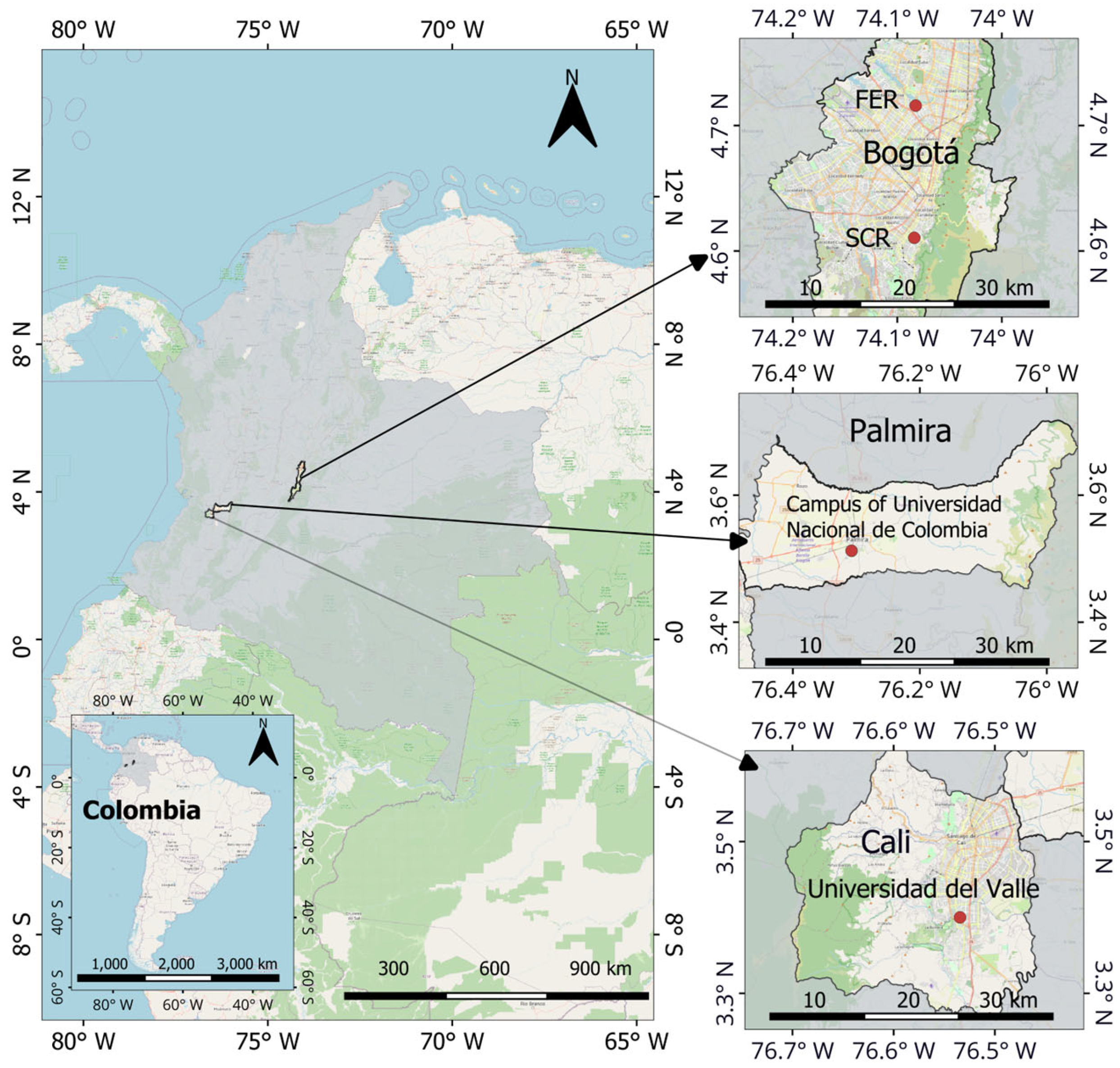
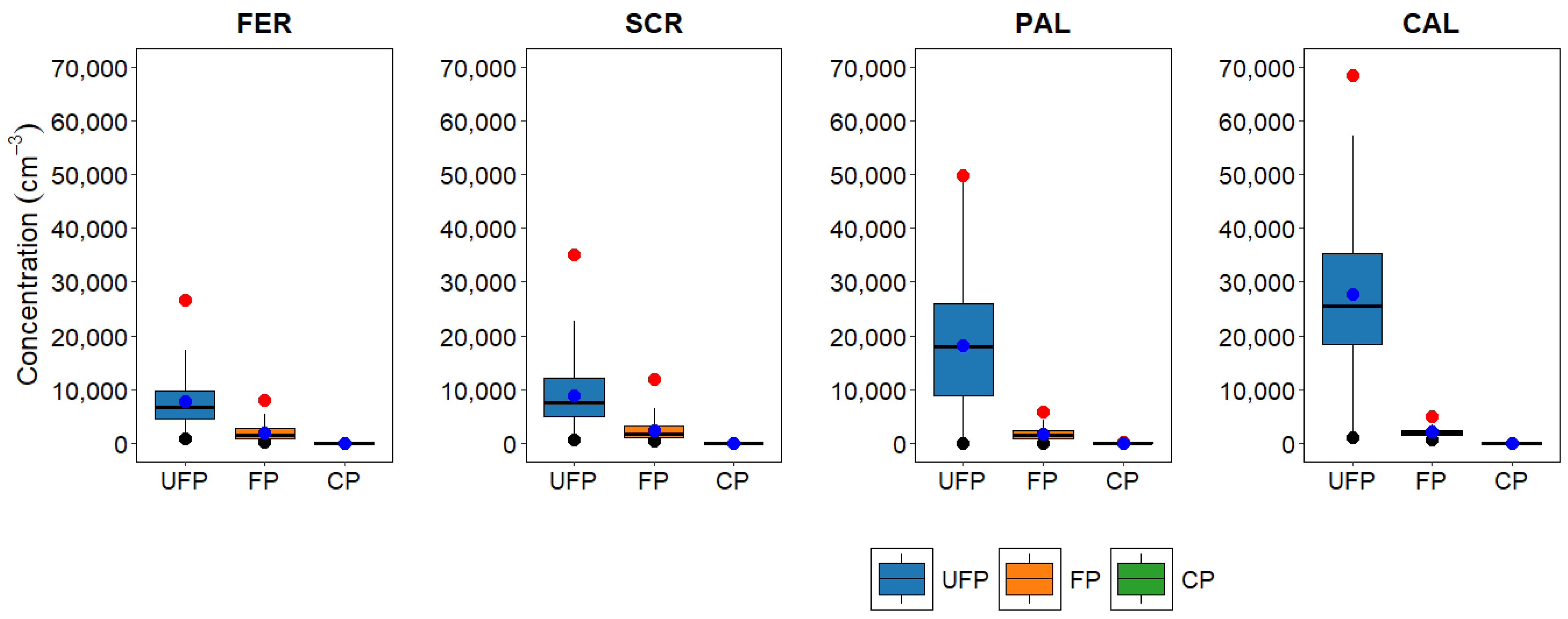


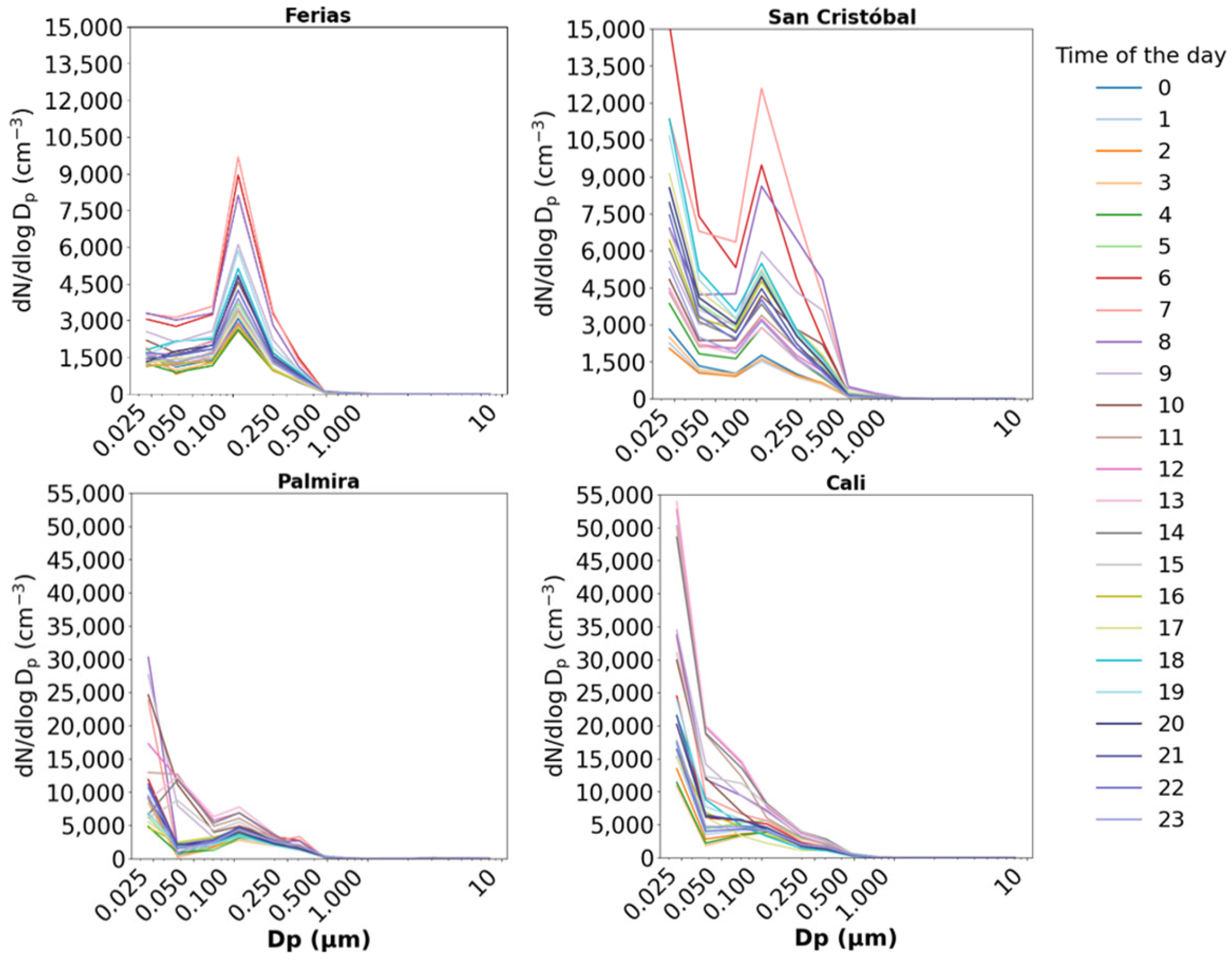

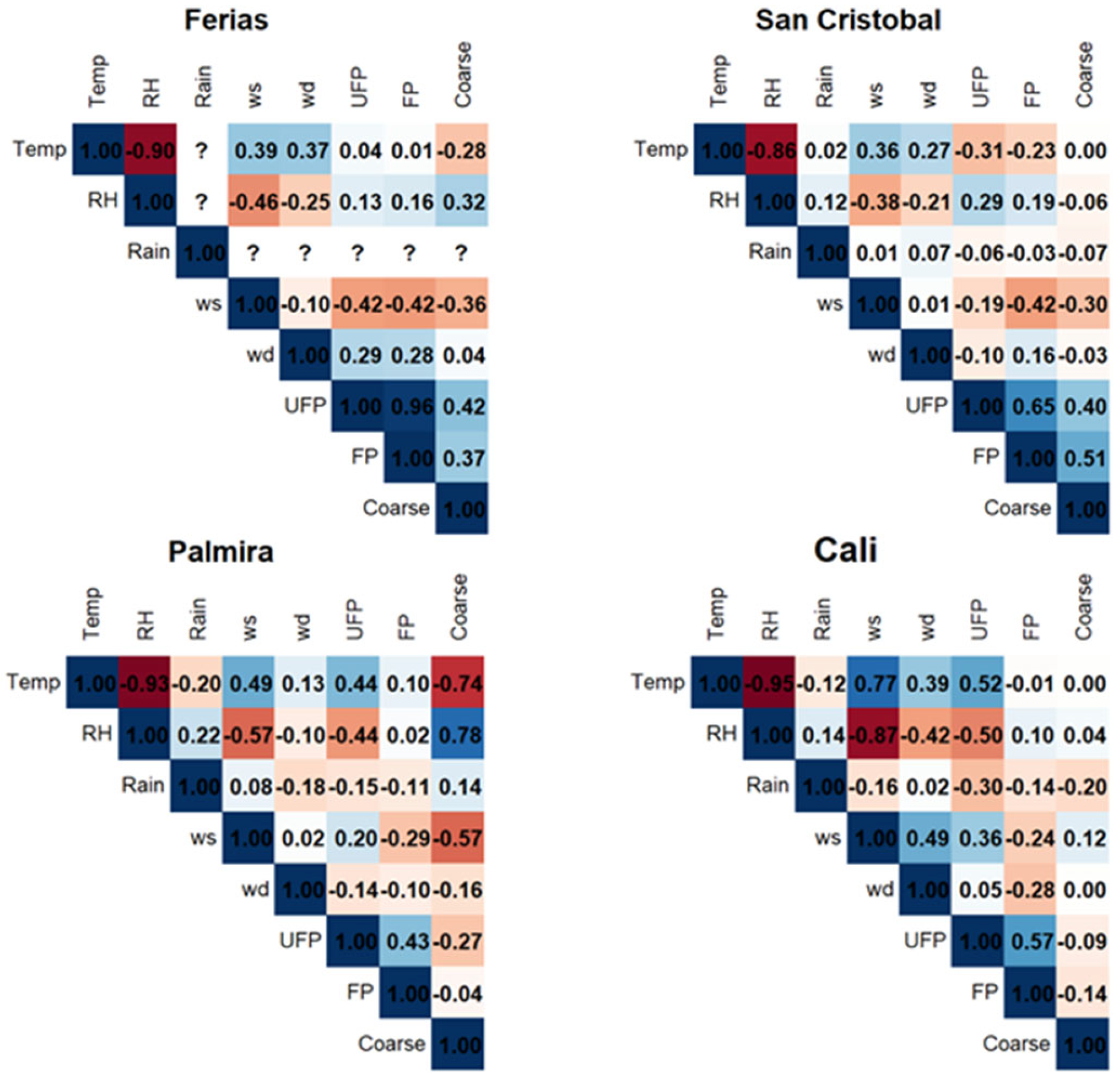
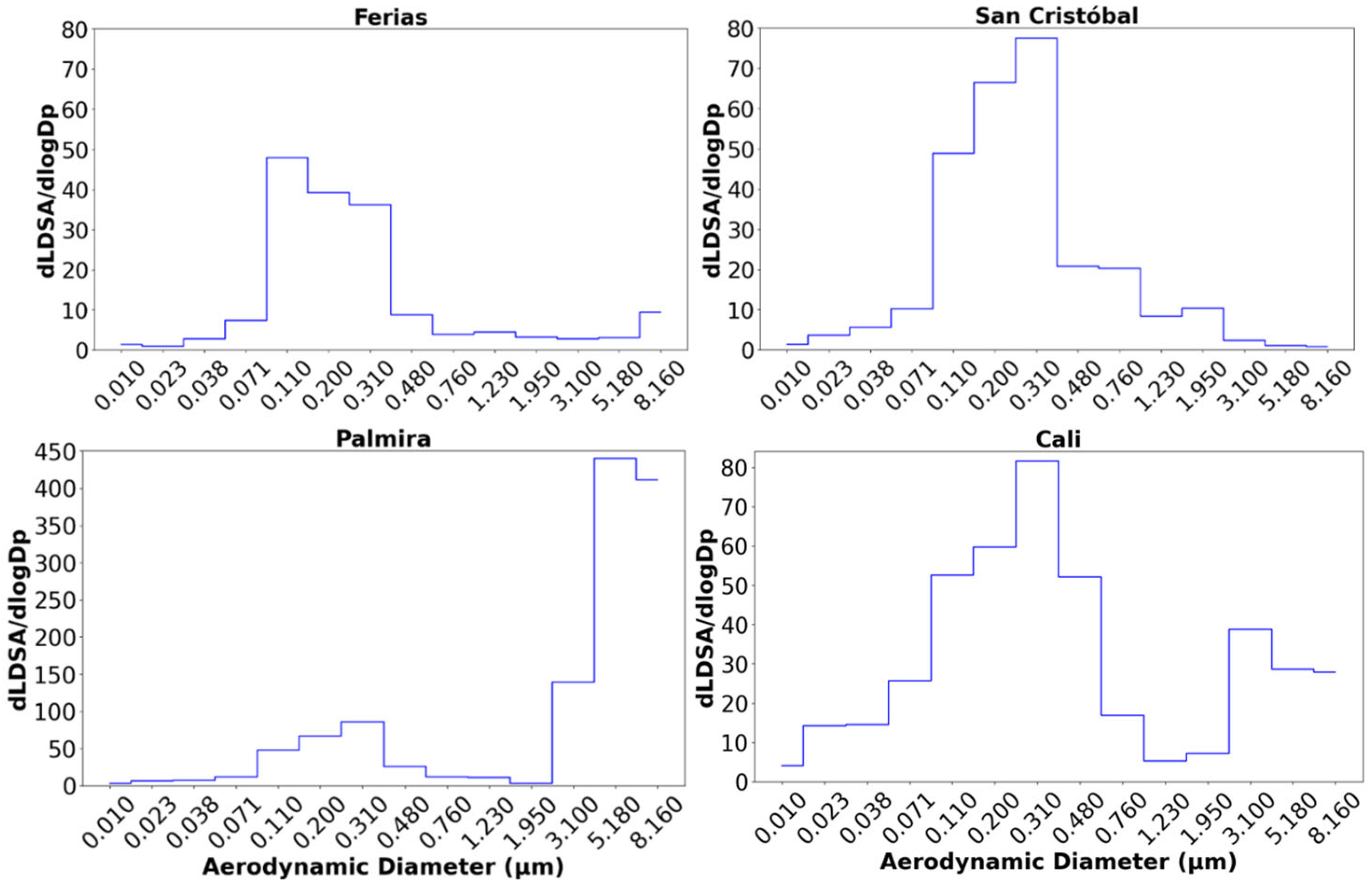
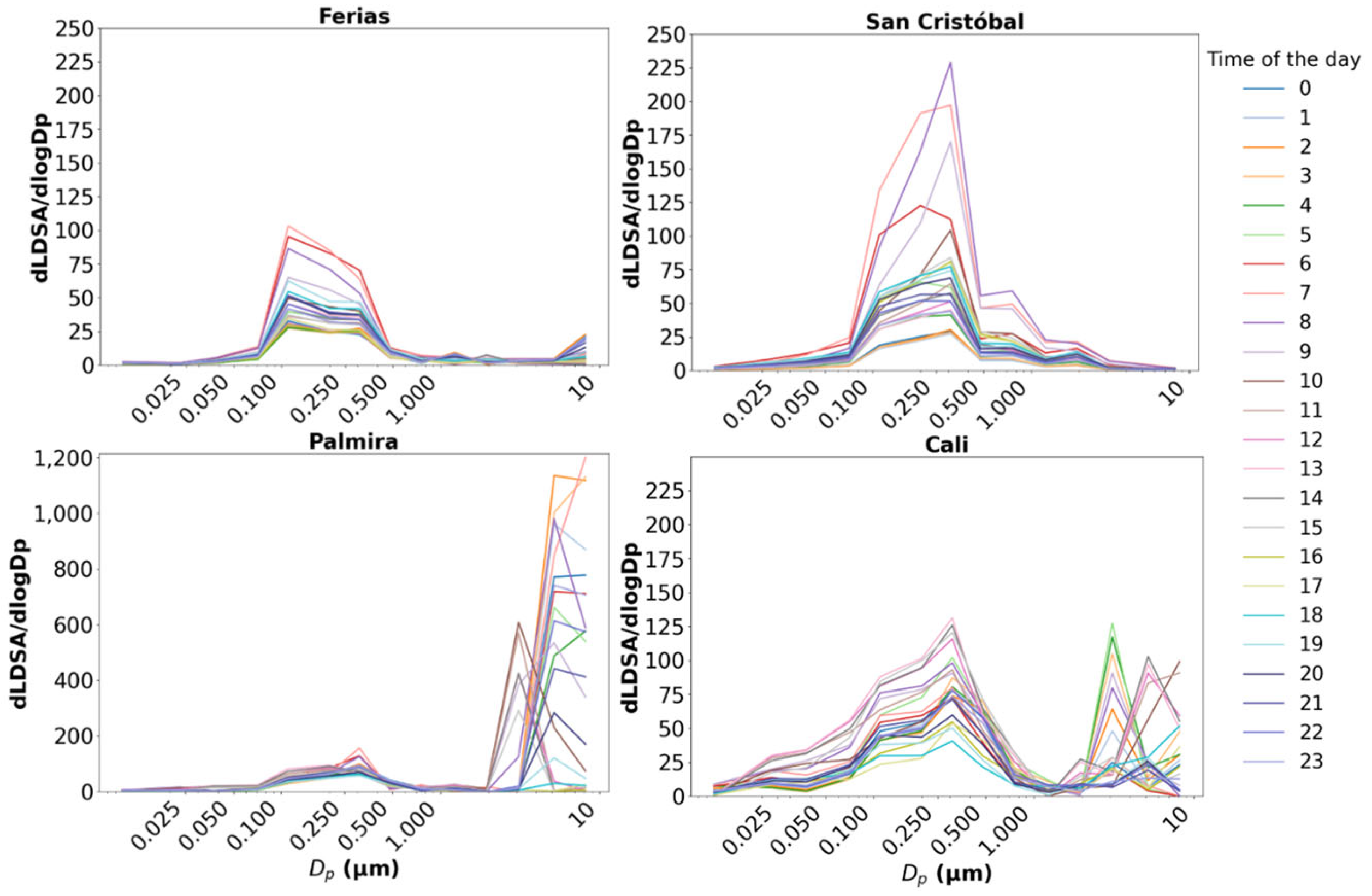
| City—Monitoring Location | Population (Millions of Inhabitants) | Temperature a (°C) | Precipitation b (mm) | PM2.5 c (µg m−3) | Zone Classification | Dates |
|---|---|---|---|---|---|---|
| Bogotá—Ferias (FER) | 7.9 | 13.1 | 797 | 13 (FER)—13 (SCR) | Urban Traffic | 23/6/2017–5/7/2017 |
| Bogotá—San Cristóbal (SCR) | Urban Background | 27/9/2017–10/10/2017 | ||||
| Palmira (PAL) | 0.35 | 23.5 | 894 | 20 | Urban–Industrial | 14/8/2018–16/9/2018 |
| Cali (CAL) | 2.3 | 23.9 | 1483 | 14 | Urban Background | 25/3/2023–29/3/2023 |
| Conversion Vectors | 1 | 2 | 3 | 4 | 5 | 6 | 7 | 8 | 9 | 10 | 11 | 12 | 13 | 14 |
|---|---|---|---|---|---|---|---|---|---|---|---|---|---|---|
| Cutting diameter Di (µm) | 0.01 | 0.023 | 0.038 | 0.071 | 0.11 | 0.20 | 0.31 | 0.48 | 0.76 | 1.23 | 1.95 | 3.10 | 5.18 | 8.16 |
| Aerodynamic Diameter D 50% (µm) | 0.006 | 0.017 | 0.03 | 0.06 | 0.108 | 0.17 | 0.26 | 0.4 | 0.64 | 1 | 1.6 | 2.5 | 4.4 | 6.8 |
| Current dI/dlogDp [fA] | 2.28 | 4.51 | 3.31 | 4.435 | 4.47 | 4.35 | 6.13 | 4.86 | 5.28 | 4.43 | 5.68 | 4.49 | 4.49 | 5.84 |
| Number dN/dlogDp [1/cm3] | 476.81 | 345.44 | 114.50 | 68.74 | 34.99 | 17.11 | 13.24 | 6.00 | 3.57 | 1.59 | 1.11 | 0.48 | 0.24 | 0.17 |
| Diameter dD/dlogDp [µm/cm3] | 4.74 | 7.36 | 4.46 | 4.91 | 4.19 | 3.45 | 4.20 | 2.91 | 2.73 | 1.96 | 2.17 | 1.48 | 1.26 | 1.41 |
| Area dA/dlogDp [µm2/cm3] | 0.15 | 0.49 | 0.55 | 1.10 | 1.58 | 2.19 | 4.19 | 4.44 | 6.56 | 7.61 | 13.37 | 14.42 | 20.44 | 36.20 |
| Volume dV/dlogDp [µm3/cm3] | 0.00 | 0.00 | 0.00 | 0.01 | 0.03 | 0.07 | 0.22 | 0.36 | 0.84 | 1.56 | 4.37 | 7.46 | 17.66 | 49.23 |
| Mass dM/dlogDp [mg/m3] | 0.00 | 0.00 | 0.00 | 0.00 | 0.00 | 0.00 | 0.00 | 0.00 | 0.00 | 0.00 | 0.00 | 0.01 | 0.02 | 0.05 |
| Current I [fA] | 1.00 | 1.00 | 1.00 | 1.00 | 1.00 | 1.00 | 1.00 | 1.00 | 1.00 | 1.00 | 1.00 | 1.00 | 1.00 | 1.00 |
| Number N [1/cm3] | 209.48 | 76.63 | 34.56 | 15.50 | 7.83 | 3.93 | 2.16 | 1.23 | 0.68 | 0.36 | 0.20 | 0.11 | 0.05 | 0.03 |
| Diameter D [µm/cm3] | 2.08 | 1.63 | 1.35 | 1.11 | 0.94 | 0.79 | 0.69 | 0.60 | 0.52 | 0.44 | 0.38 | 0.33 | 0.28 | 0.24 |
| Area A [µm2/cm3] | 0.07 | 0.11 | 0.16 | 0.25 | 0.35 | 0.50 | 0.68 | 0.91 | 1.24 | 1.72 | 2.35 | 3.22 | 4.56 | 6.20 |
| Volume V [µm3/cm3] | 0.00 | 0.00 | 0.00 | 0.00 | 0.01 | 0.02 | 0.04 | 0.07 | 0.16 | 0.35 | 0.77 | 1.66 | 3.94 | 8.43 |
| Mass M [mg/m3] | 0.00 | 0.00 | 0.00 | 0.00 | 0.00 | 0.00 | 0.00 | 0.00 | 0.00 | 0.00 | 0.00 | 0.00 | 0.00 | 0.01 |
| Particle Size | Ferias | San Cristóbal | Palmira | Cali | ||||
|---|---|---|---|---|---|---|---|---|
| PMSD | PNSD | PMSD | PNSD | PMSD | PNSD | PMSD | PNSD | |
| UFPs | 0.17% | 73% | 0.46% | 74% | 0.01% | 85% | 0.16% | 89% |
| FPs | 21% | 27% | 82% | 26% | 6% | 15% | 27% | 11% |
| CPs | 78% | 0% | 17% | 0% | 94% | 0.12% | 73% | 0.01% |
Disclaimer/Publisher’s Note: The statements, opinions and data contained in all publications are solely those of the individual author(s) and contributor(s) and not of MDPI and/or the editor(s). MDPI and/or the editor(s) disclaim responsibility for any injury to people or property resulting from any ideas, methods, instructions or products referred to in the content. |
© 2025 by the authors. Licensee MDPI, Basel, Switzerland. This article is an open access article distributed under the terms and conditions of the Creative Commons Attribution (CC BY) license (https://creativecommons.org/licenses/by/4.0/).
Share and Cite
Moreno Camacho, F.L.; Bustos Quevedo, D.; Archila-Peña, D.; Pachón, J.E.; Rojas, N.Y.; Mateus-Fontecha, L.; Blanco, K. Number Concentration, Size Distribution, and Lung-Deposited Surface Area of Airborne Particles in Three Urban Areas of Colombia. Atmosphere 2025, 16, 558. https://doi.org/10.3390/atmos16050558
Moreno Camacho FL, Bustos Quevedo D, Archila-Peña D, Pachón JE, Rojas NY, Mateus-Fontecha L, Blanco K. Number Concentration, Size Distribution, and Lung-Deposited Surface Area of Airborne Particles in Three Urban Areas of Colombia. Atmosphere. 2025; 16(5):558. https://doi.org/10.3390/atmos16050558
Chicago/Turabian StyleMoreno Camacho, Fabian L., Daniela Bustos Quevedo, David Archila-Peña, Jorge E. Pachón, Néstor Y. Rojas, Lady Mateus-Fontecha, and Karen Blanco. 2025. "Number Concentration, Size Distribution, and Lung-Deposited Surface Area of Airborne Particles in Three Urban Areas of Colombia" Atmosphere 16, no. 5: 558. https://doi.org/10.3390/atmos16050558
APA StyleMoreno Camacho, F. L., Bustos Quevedo, D., Archila-Peña, D., Pachón, J. E., Rojas, N. Y., Mateus-Fontecha, L., & Blanco, K. (2025). Number Concentration, Size Distribution, and Lung-Deposited Surface Area of Airborne Particles in Three Urban Areas of Colombia. Atmosphere, 16(5), 558. https://doi.org/10.3390/atmos16050558








